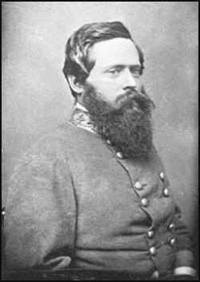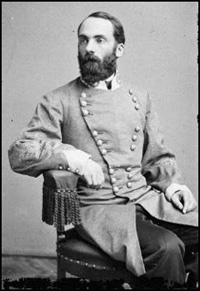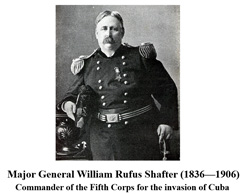
The President’s Message:
January 11, 2017 Program:
Joseph Rose will be
our speaker for the January meeting.
His topic is:
Grant Under Fire: An Exposé of Generalship & Character in the American
Civil War.
Was Ulysses S. Grant a brilliant and unparalleled general who won
the American Civil War, a magnanimous and incorruptible man, and an
honest and accurate chronicler of history? Or was he remarkably
untruthful, careless, persistent, indolent, aggressive, unjust, biased,
impetuous, and lucky?
A stringent and
detailed examination of Grant’s generalship and character in the war has
long been necessary. Standard histories and biographies, founded on a
lengthy succession of biased and erroneous writings, have much of it
wrong. Many of these inaccuracies originated with the General himself,
in his official reports, in his Personal Memoirs, and in his other
writings. While Grant possessed many positive attributes and achieved
valuable objectives, his reputation as a military mastermind with a
virtuous character is hopelessly exaggerated. Grant Under Fire: An
Exposé of Generalship & Character in the American Civil War, thoroughly
establishes this.
December 14, 2016 Program:
 We
had the honor, once again, to have as our speaker for the Holiday Dinner
Party, renown author and historian Robert N. Macomber.
His topic, designed specially for our group was titled
Confederate Generals in Union Blue — 33 Years Later!
Four former Confederate generals volunteered for service in the
Spanish-American War and were chosen by President William McKinley,
himself a combat veteran of the War Between the States.
They were Thomas Rosser, Matthew Butler, Fitzhugh Lee, and Joe
Wheeler. The presentation
was about the two most famous, Lee and Wheeler, both of whom became
major generals in the US Army thirty-three years after they’d fought to
defeat it. We
had the honor, once again, to have as our speaker for the Holiday Dinner
Party, renown author and historian Robert N. Macomber.
His topic, designed specially for our group was titled
Confederate Generals in Union Blue — 33 Years Later!
Four former Confederate generals volunteered for service in the
Spanish-American War and were chosen by President William McKinley,
himself a combat veteran of the War Between the States.
They were Thomas Rosser, Matthew Butler, Fitzhugh Lee, and Joe
Wheeler. The presentation
was about the two most famous, Lee and Wheeler, both of whom became
major generals in the US Army thirty-three years after they’d fought to
defeat it.
Fitzhugh “Fitz” Lee
was the grandson of
"Light Horse Harry" Lee of Revolutionary War fame, a nephew of Robert E.
Lee. His father, Sydney Smith Lee, was a US naval officer who served
under Commodore Perry in Japanese waters and rose to the rank of
Captain; then joined the CSN for the Civil War.

Fitz Lee graduated
from the USMA in 1856 and served as a cavalryman out west, at one point
in a regiment under his uncle Robert.
He joined the CSA, fought with the Army of Northern Virginia, and
rose in the cavalry ranks to Major General; widely regarded as one of
the CSA’s best cavalrymen.
He surrendered with the army at Appomattox, after leading the last
Confederate cavalry charge of the war.
After the war, Fitz
Lee was, like his uncle, a voice for reconciliation.
He became governor of Virginia in 1886, a friend of President
Grover Cleveland in the 1880s, and became influential in the Democratic
Party. During Cleveland’s second term, Fitz was appointed US
Consul-General in April 1896, during the bloody Cuban revolution for
independence from Spain; a very hot diplomatic post.
 Although
of New England ancestry,
Joseph Wheeler
was born near
Augusta, Georgia and spent most of his early life growing up with
relatives in Connecticut. He
was the grandson of Brigadier General William Hull, a veteran of the
American Revolution who was court-martialed for surrendering at Detroit
early in the War of 1812. Although
of New England ancestry,
Joseph Wheeler
was born near
Augusta, Georgia and spent most of his early life growing up with
relatives in Connecticut. He
was the grandson of Brigadier General William Hull, a veteran of the
American Revolution who was court-martialed for surrendering at Detroit
early in the War of 1812.
Despite his northern
upbringing, Wheeler was appointed to the United States Military Academy
at West Point from the state of Georgia.
He always considered himself a Georgian and Southerner.
He graduated from the USMA in 1859 (19th out of 22 cadets).
He was posted in the cavalry in New Mexico fighting Indians,
where he got the nickname “Fighting Joe.”
He joined the CSA and
first served under Bragg at the siege of Pensacola, then fought in the
Western Theater for the rest of the war.
He was wounded three times and had 16 horses shot out from under
him. He was captured in
Georgia while trying to protect Jefferson Davis escape.
After the war,
Wheeler was a gentleman farmer and lawyer in northern Alabama.
He won a congressional seat in 1882, which he held until 1900.
He became very influential in Democrat politics in the 1880s and
1890s. He also was a voice
for reconciliation.
 As
a veteran of Antietam, President McKinley knew the horrors of combat,
and tried to dampen the shouts for war both before and after USS Maine
was destroyed. But, two
months after that terrible explosion in which 266 American sailors died,
Congress voted for war.
McKinley plunged into his work as commander-in-chief with a will.
One of his primary goals was to unite the country around the war
effort, using this new conflict to bring the South back into the
national fold. Two of the
four former Confederate generals who had volunteered McKinley knew
personally, his consul-general in Havana Fitz Lee, and the well-known
congressman Joe Wheeler. Not
only were they Southerners, but they were Democrats. As
a veteran of Antietam, President McKinley knew the horrors of combat,
and tried to dampen the shouts for war both before and after USS Maine
was destroyed. But, two
months after that terrible explosion in which 266 American sailors died,
Congress voted for war.
McKinley plunged into his work as commander-in-chief with a will.
One of his primary goals was to unite the country around the war
effort, using this new conflict to bring the South back into the
national fold. Two of the
four former Confederate generals who had volunteered McKinley knew
personally, his consul-general in Havana Fitz Lee, and the well-known
congressman Joe Wheeler. Not
only were they Southerners, but they were Democrats.
Volunteer Major
General Fitz Lee was given command of the Seventh Corps, a primarily
state volunteer formation of three divisions staging at Jacksonville,
Florida. This force was
preparing for the impending invasion of western Cuba and Havana.
It was expected to be a bloody fight, since most of the Spanish
defenses were in that area.
Lee did admirable work in gathering, training, and equipping his 30,000
men, in spite of the fact the US Army was woefully unprepared for the
war. The Army went from
27,500 regular peacetime soldiers to 275,000 mostly volunteers in the
space of five months; the logistics couldn’t keep up.
Volunteer Major
General Joe Wheeler was assigned to command the cavalry division of the
Fifth Corps, which was assembling at Tampa, Florida.
Most of this three-division corps was composed of regulars, with
several volunteer regiments, most notable of which were the Rough Riders
of Colonel Leonard Wood and Lt. Col. Theodore Roosevelt.
The 30,000 men in the Fifth Corps were under the command of Major
General William Rufus Shafter, with Wheeler as his second-in-command.
Shafter was not a successful administrator or combat commander,
but he had excellent division and brigade commanders who did their best.
The staging area at Tampa was complete chaos, with many of the
newly arriving volunteer troops unfamiliar with their weapons, and some
without any weapons or any other equipage.
Corps, which was assembling at Tampa, Florida.
Most of this three-division corps was composed of regulars, with
several volunteer regiments, most notable of which were the Rough Riders
of Colonel Leonard Wood and Lt. Col. Theodore Roosevelt.
The 30,000 men in the Fifth Corps were under the command of Major
General William Rufus Shafter, with Wheeler as his second-in-command.
Shafter was not a successful administrator or combat commander,
but he had excellent division and brigade commanders who did their best.
The staging area at Tampa was complete chaos, with many of the
newly arriving volunteer troops unfamiliar with their weapons, and some
without any weapons or any other equipage.
Fifth Corps was
assigned to invade eastern Cuba, capture Santiago, and assist the US
Navy in the destruction of the Spanish fleet there anchored.
The invasion was a completely befuddled affair, saved from
disaster by the Cuban Army, which drove off the Spanish defenders to
allow the Americans to land without fighting.
Shortly thereafter,
Shafter learned the Spanish and miserable logistics weren’t his only big
problems. Wheeler attacked
on his own, against orders, and got the cavalry (who were without
horses, another supply mess—only senior officers had mounts) into a
sharp fight at Las Guasimas.
This is where American blood was first drawn by the enemy (Puerto Rican
militia sent to Cuba) and it quickly got out of hand.
Finally, by force of willpower, the regular cavalrymen (most were
black) overcame the defenses, whereupon Wheeler, full of excitement,
forgot what war he was in and yelled to go get ‘em boys, we got them
Yankees on the run!
Wheeler was a
critical part of the ensuing battles, leading from the front lines in
spite of being feverish, and pushing the troops forward.
In the end, he garnered the respect of the various troops, both
black and white, and especially of the officers, including Roosevelt.
When the troops were
finally pulled out of Cuba after the Spanish surrender, having lost far
more men from tropical diseases than from enemy bullets, the corps was
quarantined at Camp Wikoff on Long Island, NY, where Wheeler was put in
command.
Fortunately, Fitz
Lee’s Seventh Corps was never called upon to invade western Cuba, but
elements of it did go on occupation duty there, and Lee himself became
governor of Havana and the western end of the island.
After the Spanish-American War Fitz Lee stayed in the army.
He was named governor of Havana and western Cuba in 1899, then
commanding the Department of Missouri 1900, and finally retiring in
1901. He wrote two books
about the Civil War and one about the Spanish-American War
Joe Wheeler was sent
to the Philippines and commanded a brigade there in the nasty jungle war
against the Filipino insurrectionists.
After serving in combat for a year, he rotated home and commanded
the Department of the Lakes in the mid-West.
He retired in 1901 and moved to New York City.
Shafter retired in
1901 and moved to a 60 acres farm in Bakersfield, California.
He died there in 1906 at age 71 and is buried at San Francisco
National Cemetery.
Fitz Lee died in
1905, four years after his military retirement, at age 69.
He is buried at Hollywood Cemetery in Richmond.
After long illness,
Wheeler died in Brooklyn, NY, in 1906, at the age of 69.
He is one of the few former Confederate officers to be buried
within Arlington National Cemetery.
And finally, I want
to share with you this great story about Joe Wheeler:
While attending the
hundredth anniversary of the U.S. Military Academy in 1902, Wheeler
approached the old West Point hotel, where his Confederate comrades
James Longstreet and Edward Porter Alexander were seated on the porch.
Wheeler was wearing his dress uniform of a general in the US
Army.
Longstreet reportedly
said, "Joe, I hope that Almighty God takes me before he does you, for I
want to be within the gates of hell to hear Jubal Early cuss you in the
blue uniform." (Longstreet did in fact predecease Wheeler, dying in
January 1904.) And so now
you know how two famous Confederate generals became famous US Army
generals thirty-three years after the Civil War!
Last changed: 12/23/16
Home
About News
Newsletters
Calendar
Memories
Links Join
|

